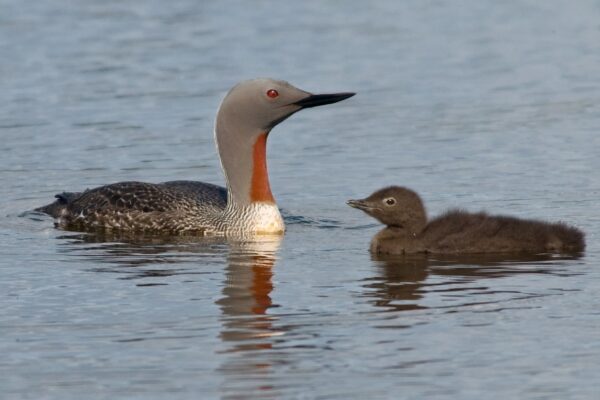Offshore wind farms in the North Sea reduce the population of loons –fish-eating aquatic birds also known as divers – by 94% within a one-kilometre zone, according to new research published in Scientific Reports. The findings highlight the need to minimise the impact of offshore wind farms on seabirds, while balancing this effort with the demand for renewable energy, the authors said.
The red-throated loon, also known as the red-throated diver, is the smallest and lightest of the UK’s diving birds. Most of its food is fish, which it catches by swimming underwater for up to 90 seconds at a time.
Distribution and abundance changed significantly after windfarms were built
Previous research has found that different seabird species respond to offshore windfarms differently – they may avoid the area which can lead to habitat displacement or they may be attracted to the area which can increase mortality via collisions with the turbines. However, it is difficult to estimate the long-term population impacts of offshore windfarms on seabird populations.
Stefan Garthe and colleagues investigated how red-throated loon abundance changed before and after the construction of five offshore windfarm clusters in the southeastern North Sea dubbed BARD/Austerngrund, Dan Tysk, Butendiek, Helgoland, and North of Borkum. The authors used data on loon numbers from ships, aircraft, and digital aerial surveys collected during March and April between 2010 and 2017. They modelled how the density of loon populations changed within the area up to and beyond ten kilometres away from the windfarm.
The authors report that distribution and abundance of loons changed significantly after the windfarms were built, with a low abundance of loons in the immediate vicinity of the turbines creating a ‘halo effect’. Loon numbers decreased by 94% within one kilometre of the windfarms, and 54% within ten kilometres.
In particular, loons completely disappeared from the vicinity of BARD/Austerngrund and North of Borkum windfarm clusters. The birds instead congregated at high densities in an area to the north west of the Helgoland windfarm cluster. Overall, the total population estimate of loons fell by 29.24% from 34,865 individuals before windfarm construction to 24,672 birds after construction. The authors report that no other seabirds had such a significant negative reaction to the presence of the windfarms.
Substantial worry
“This worries us substantially,” said Stefan Garthe, a co-author of the paper and a marine ecology professor at Kiel University in Germany. “While we acknowledge the urgent need for renewable energy, we face the problem that wind farms hardly provide any benefit for seabirds.” The installation of wind turbines offshore isn’t always bad news for marine conservation. For instance, mollusks and small fish have been shown to turn turbines into artificial reefs Bloomberg reported.
Aly McCluskie, senior conservation scientist at RSPB, told The Daily Telegraph: “This helpful new study adds to the existing evidence that offshore wind farms can have major impacts on birds.”
The authors suggest that the construction of the offshore windfarms will have affected how the loons forage for fish, as their movements are now restricted to smaller areas. They recommend increasing the study of cumulative effects of windfarms throughout the year across the entire region of farms.
Further information:
Media coverage of this story can be found in the Daily Telegraph [paywall] and Bloomberg [paywall].
The full peer-reviewed journal paper in Scientific Reports can be read here.
